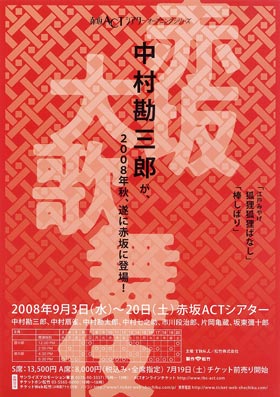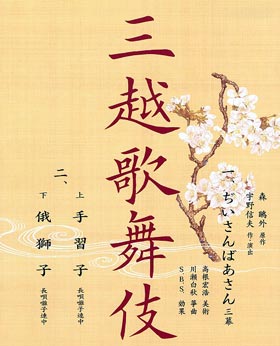| Comments |
This is the 3rd edition of a special program called "Shűzan Matsuri" (the festival of Shűzan), which is produced at the Kabukiza
to commemorate the great actor Nakamura Kichiemon I, whose's haimy˘ was Shűzan.
The star of this program is his adopted son Nakamura Kichiemon II.
Ry˘ma ga Yuku: this is a dramatization of the middle section of the tremendously popular
historical novel by Shiba Ry˘tar˘ (1923~1996) about Sakamoto Ry˘ma (1836~1867), a visionary revolutionary
at the end of the Tokugawa Period who brought various rival factions together to battle the Shogunate
and would have led Japan boldly, if he had not been assassinated in a bloody battle.
Starring Somegoro as Ry˘ma with Ichikawa Kamejir˘, Onoe Sh˘roku and Nakamura Kinnosuke.
Sakaro:
(The Rise and Fall of the Heike Clan - Reverse Rowing)
A period play taken from the Bunraku puppet theater
which combines a historical tale with the daily life of commoners.
Matsuemon (Nakamura Kichiemon) has married into the family of a country boatman. Having learned the special
rowing skills of his father-in-law, he is invited to transport the Genji general Yoshitsune.
But Matsuemon is actually the warrior Higuchi Kanemitsu, a leading retainer of a general killed by Yoshitsune and he sees this as a perfect opportunity to take his revenge. Before he can put his plan
into action, though, his identity is discovered and he is captured in a spectacular battle on
sea and land. Featuring Living National Treasure Nakamura Tomijűr˘ in the role of Hatakeyama Shigetada.
Nihon Furisode Hajime: this dance is a rare example of a story from ancient Japanese
mythology in a puppet play by Chikamatsu Monzaemon adapted for the Kabuki theater.
As part of an annual ritual, Princess Inada has been chosen to be sacrificed to a fierce serpent
that lives in the mountains of Izumo. The serpent arrives in the guise of a beautiful princess,
but before it can attack it is attracted to eight jars full of sake.
The jars are a trap planted by the god Susanoo, who confronts the beast in its true form as an
eight-headed serpent, to save the princess. Starring Band˘ Tamasabur˘ as the serpent,
with Ichikawa Somegor˘ and Nakamura Fukusuke in the roles of Susanoo and Princess Inada.
Moritsuna Jin'ya: this play is one of the greatest classics of the jidaimono
historical play style. Two brothers, Moritsuna and Takatsuna are generals on
opposing sides. Moritsuna's forces are greater in number and strength, but
his brother's brilliant strategies allow him to escape by preying on
Moritsuna's psychological weaknesses. Ruthlessly, Takatsuna has his son
sacrifice his life to force Moritsuna to identify the head of an imposter
as that of his dead brother. Starring Nakamura Kichiemon as Moritsuna,
with Nakamura Shikan as Mimy˘, the mother of the
two brothers, Nakamura Fukusuke as Kagaribi, the wife of Takatsuna, and Ichikawa Sadanji as the crafty general Wada no Hy˘e.
Tobae: tobae are light, comical sketches
drawn by the monk of Toba. This dance shows a man awakened late at night to see what he imagines
is the pestle from a kitchen mortar and pestle growing wings and flying -an image worthy of a tobae -only
to find that it is a giant rat. He performs a series of comical dances with the rat, including
a highly exaggerated love scene. Starring Living National Treasure Nakamura Tomijűr˘ as the man and his son Nakamura Takanosuke as the rat.
K˘chiyama: the tea priest K˘chiyama (Nakamura Kichiemon) is a skilled thief and
extortionist, but cannot turn down a request to help those in need.
He disguises himself as a high-ranking priest to try to gain the freedom of a
girl held by a powerful samurai lord (Ichikawa Somegor˘) because she will not become his mistress.
Using the famous poetic cadences of the late 19th century playwright Mokuami,
K˘chiyama not only succeeds in his mission to rescue the girl, but he manages to
extort a fair amount for himself.
Source: Earphone Guide website
|



